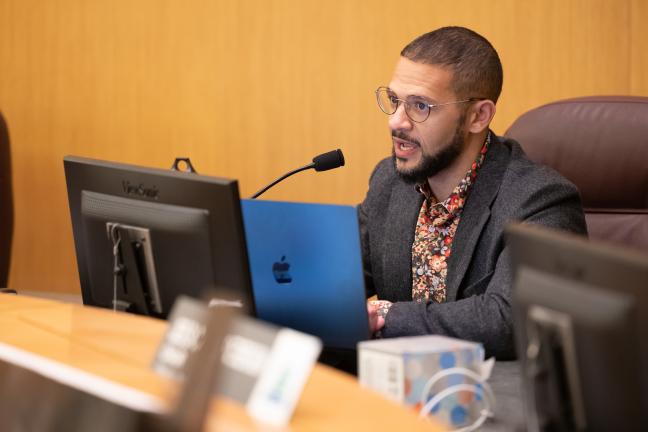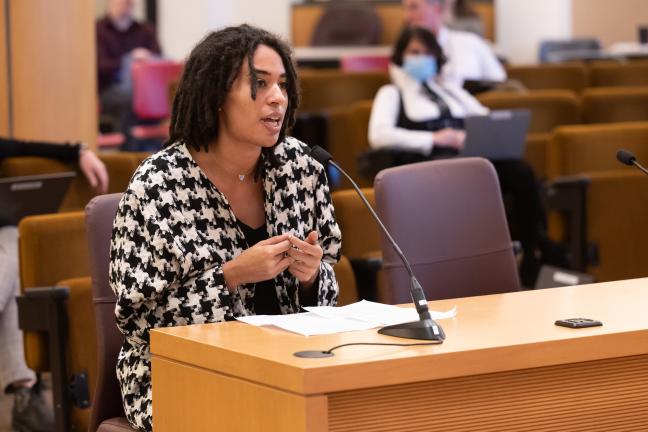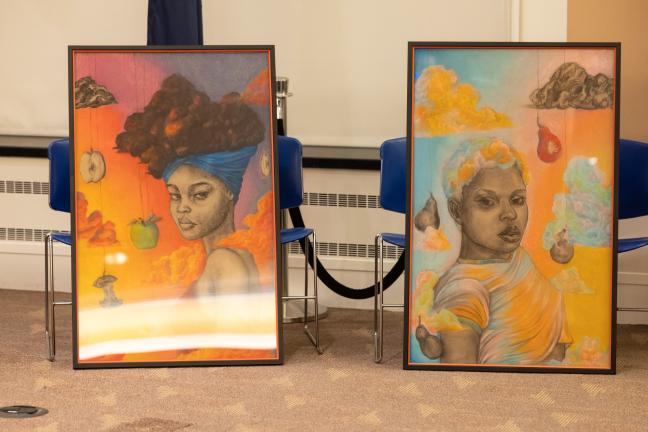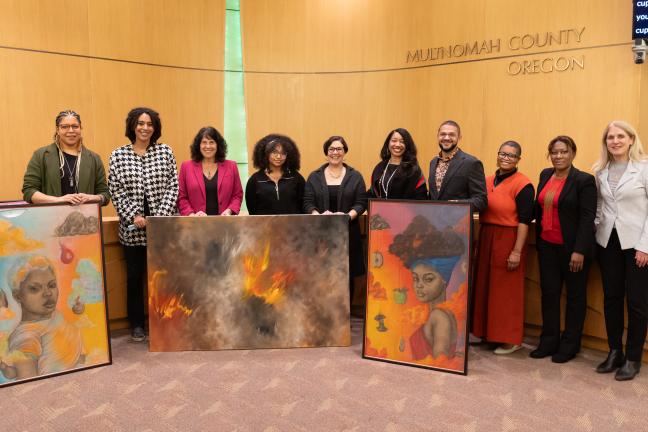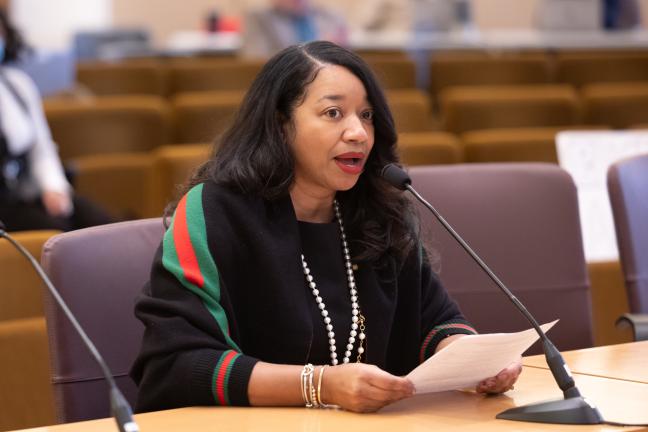On Thursday, Feb. 22, the Multnomah County Board of Commissioners proclaimed February 2024 as Black History and Futures Month. This year’s proclamation, focused on the intersection of Black art and environmental justice, was cosponsored by Commissioner Jesse Beason and the Office of Sustainability.
Commissioner Beason introduced the proclamation by recognizing the groundbreaking work of Black women in Oregon who’ve made lasting impacts in our region — from Mary Beatty, a suffragist who in 1872 cast a ballot in a Portland election decades before women’s right to vote would be recognized by law, to Gladys McCoy, who in 1970 became the first Black person elected to public office in Oregon, starting on the Portland Public Schools Board before eventually serving as Multnomah County Chair.
“Whether it is art, culture, entrepreneurship, social movements, environmental justice — for centuries, Black women like Mary Beatty and Gladys McCoy have often been at the forefront of pushing our country to be better, to deliver on the great promise of our nation,” Commissioner Beason said. “They do not get the credit they deserve. And yet, they’ve been doing it anyway — and right here in Oregon, too.”
He said the presenters helping announce the proclamation, including County staff and local artists, all carry forward the legacy of those Black women from Portland and Multnomah County history.
“It is no wonder that today we are joined by some amazing Black women who are carrying this tradition of leadership forward,” Commissioner Beason said. “They join us to celebrate this February, and to mark where we have been and where we must go, to mark our Black history and our Black futures.”
Presenters focused on environmental sustainability and art as key elements of both Black history and Black futures.
“I want to shed light on a powerful intersection that goes unnoticed: the connection between Black art and the environmental justice movement,” said Monique Smiley, Sustainability Engagement Specialist from the Office of Sustainability. “Black artists and storytellers have been at the forefront of movements for environmental justice — their work depicts the complex relationship between racism and environmental impacts. It serves as a potent tool for raising awareness, instigating change and fostering solidarity.”
Smiley said environmental justice is focused on ensuring safe and healthy environments for all people, regardless of race or class, and that Black artists ignite change through many forms of art — literature, visual arts, performing arts, fashion, music, food, and more. Through art, the messages carry through the past, present and future, Smiley said.“Black artists challenge the dominant narratives surrounding environmental issues, amplifying voices that are often silenced or overlooked. They expose the disproportionate impacts of pollution, climate change, and environmental racism on Black and Indigenous communities, emphasizing the urgent need for systemic change,” she said. “In the face of adversity, they have embraced their roles as catalysts for progress, using their artistry to create a more just, inclusive and empathetic world.
“As we celebrate Black History & Futures Month, let us not only reflect on the past but also look towards the future. Let us commit to supporting Black artists and cultural leaders in their efforts to promote environmental justice and sustainability.”
Presenters from the Multnomah County Library highlighted the Library’s work to connect the Black community with the arts. Carla Davis from Black Cultural Library Advocates (BCLA) and Every Child A Reader (ECAR) explained how the two programs connect children with literacy resources and literature that is culturally specific.
“With the ECAR program, I have the privilege of serving our children ages 0 to 5 with books on a rotational basis, with books that are culturally appropriate as well as age-appropriate,” Davis said. “We also share with parents and caregivers why to read with their children in their early years of brain development, and why it’s so important, and which science shows can result in greater academic success.”
“Literary arts impart not only world knowledge, but open the door to imagining the possible,” Davis said. “When our children see people who look like them and see them excelling, they are also inspired to greatness.”
Israel Fin, BCLA’s community engagement coordinator, said the Library is making a difference by increasing access to resources for Black community members that respond to community needs.
“In addition to providing excellent service and bridging the gap between library institutions that historically disenfranchised Black learners and upheld barriers to access to various forms of literacy, our team is dedicated to connecting folks to their roots and paving the way for Black residents of Multnomah County to create their own rich histories,” Fin said. “Through classes, events, community outreach, and incredible programs like Every Child a Reader, [through] our adult literacy programs, targeted digital access and equity efforts, and the creative youth development program at Donald E. Long, BCLA aims to meet the community need not just this month of February, but 365 days a year.”The presentation also featured artists who explained how their work ties together sustainability with Black history and futures.
Zoë Gamell Brown, founder of Fernland Studios — which provides Black, Indigenous, and people of color opportunities to sustain their relationship with the land through artist residencies, ecological arts funding and writing retreats — highlighted the interconnected nature of Black liberation and ecology.
“A workable future requires Black liberation and Indigenous sovereignty rooted in the land. There is a need for an ecosystem of resources to heal our community’s harms, from the Middle Passage to our current battles with educational resources for our youth, and environmentally conscious shelters and homes for our communities,” she said. “Like seeds sown into hair to preserve African foods, art has allowed the Black communities to carry our cultures forward, affirming joy, resistance, grief and survival. Art allows us to plant those seeds for dreams of futures beyond our present, clear view.”
“I close today with an invitation to carve out spaces for creative ecological justice where the use of art to heal our spirits, communities and ecologies, with us, so we can tend to the seeds of our futures tomorrow,” she said.
“I have a special interest in the parallels between our existence and the natural world. The cycles of chaos and destruction are needed to give way to new life. A volcanic eruption may cause irreversible damage to its surroundings, but its result is the richest and most fertile soil,” she said. “In exploring these parallels and natural relationships, I’m learning to navigate chaos and change in my own life. I’ve lost family and friends, have experienced violence and bias, and have existed in various states of health. Through persistence, determination and the support of my community, I’ve learned and gained so much.”
“The world we live in today is not the world of yesterday, and it isn't the world of tomorrow. We are living at a precarious but pivotal time. No one knows what will happen, but fostering community, freeing those held under oppression and conflict, and taking care of our planet can only lead to a more positive, bountiful future,” she said.
The Board of Commissioners expressed gratitude for the presenters for the work they do and the value it brings to the community. “Sharing your strength and your love and your resilience, it really empowers others and really brings joy to my heart. So thank you for being here,” said Commissioner Lori Stegmann.
“I'm sort of speechless right now after each of you speaking. And I don't want my words to detract from the transcendent beauty and power of what each of you have said,” said Commissioner Sharon Meieran. “Thank you for all that you do.”
“The panel today did a great job representing the theme — Black Histories and Futures. Not just a look back, but the present and the future,” said Commissioner Julia Brim-Edwards. “I'm just going to say thank you to all of you for presenting and sharing with us today.”
“I want to thank you all for being here today for all the work you do in serving our communities and the work you do,” said Chair Jessica Vega Pederson. “We are making a better place for hopefully every Black resident in Multnomah County, but really all of us here in Multnomah County, through the work that you all do.”
“Thank you all for the work that you do for Black people and humanity in general. We are made better for it,” Commissioner Beason said to the panelists. “As Theresa tha S.O.N.G.B.I.R.D. says in her poem ‘You So Black,’ Black is adjective, adverb, color and noun, and I think we saw a little bit of that today.”Commissioner Beason and Joy Fowler, Chief Diversity and Equity Officer for the County, then traded off reading passages from the proclamation, which was unanimously adopted by the Board of County Commissioners.
“We join these two — Black History and Black Futures Month — in an example of ‘Sankofa,’ a word and symbol from the Akan tribe in Ghana. Literally translated, Sankofa means ‘it is not taboo to fetch what is at risk of being left behind.’ The symbol is based on a mythical bird with its feet firmly planted forward and its head turned backwards,” Commissioner Beason read. “We believe, as the Akans believe, that our present reflects our past, and that we can repair historic and current wrongs to create a future where everyone and every community thrives.”
“The observance of Black History and Futures Month calls on us to confront racism, to rectify the parts of our history that continue to shape who gets access to opportunity, and to build a society that lives up to the ideals to which our Constitution aspires,” Fowler read. “We recognize that a more just future requires rethinking, reimagining, reprogramming and evolving how we’ve structured our economies, our governments and our communities. We endeavor to do just that, while uplifting the dignity and power of Black people.”
